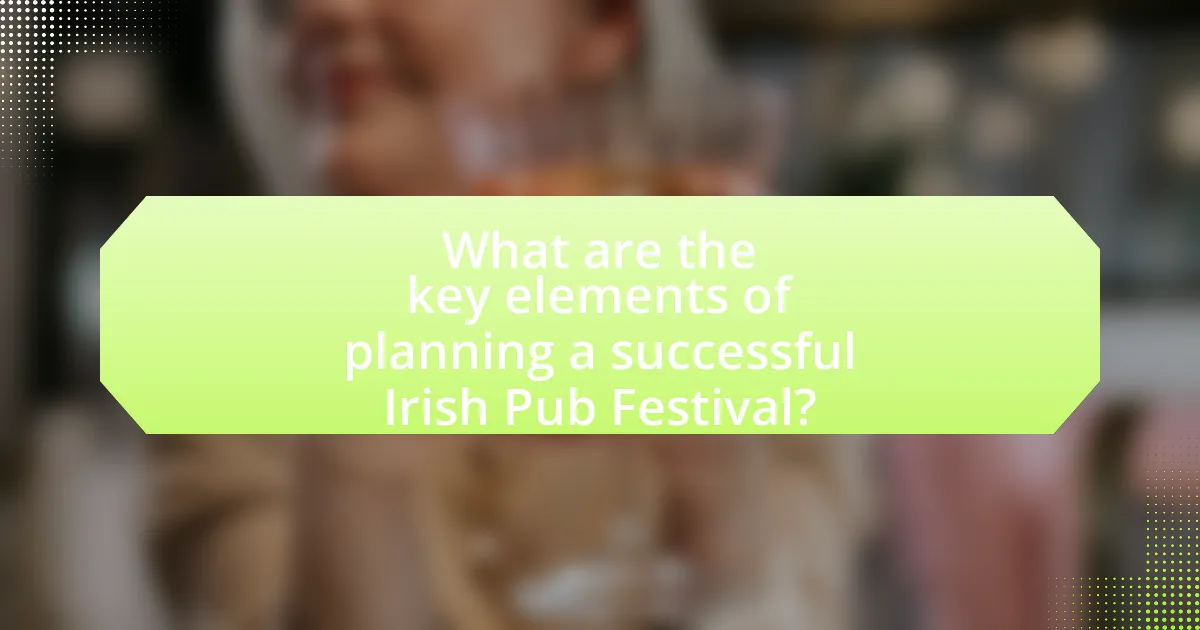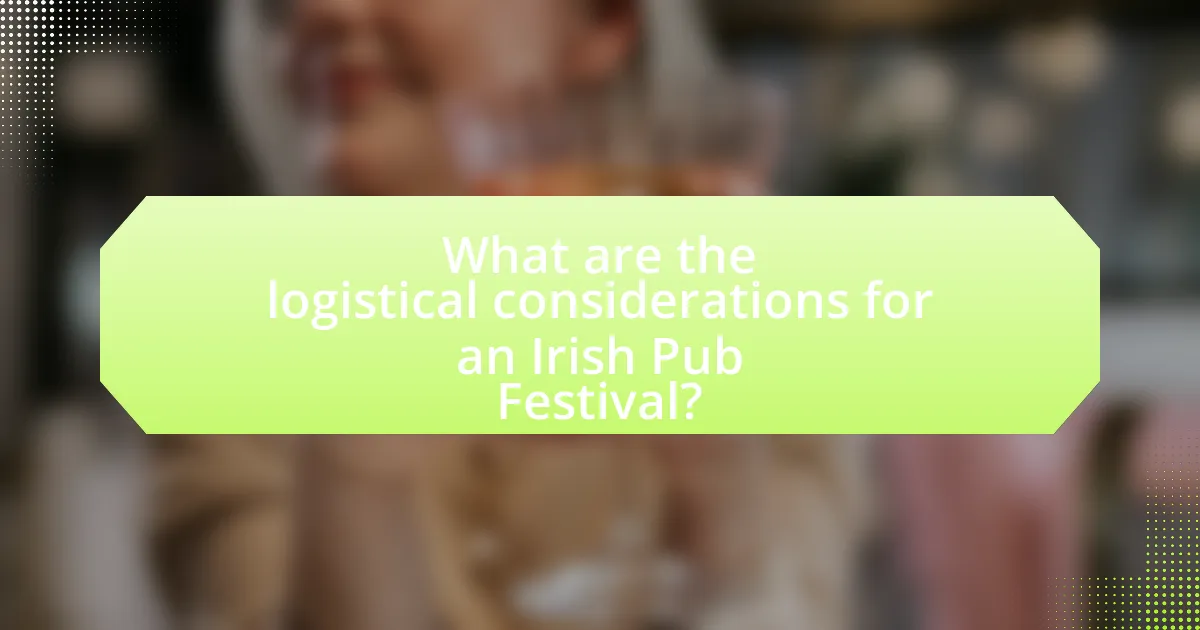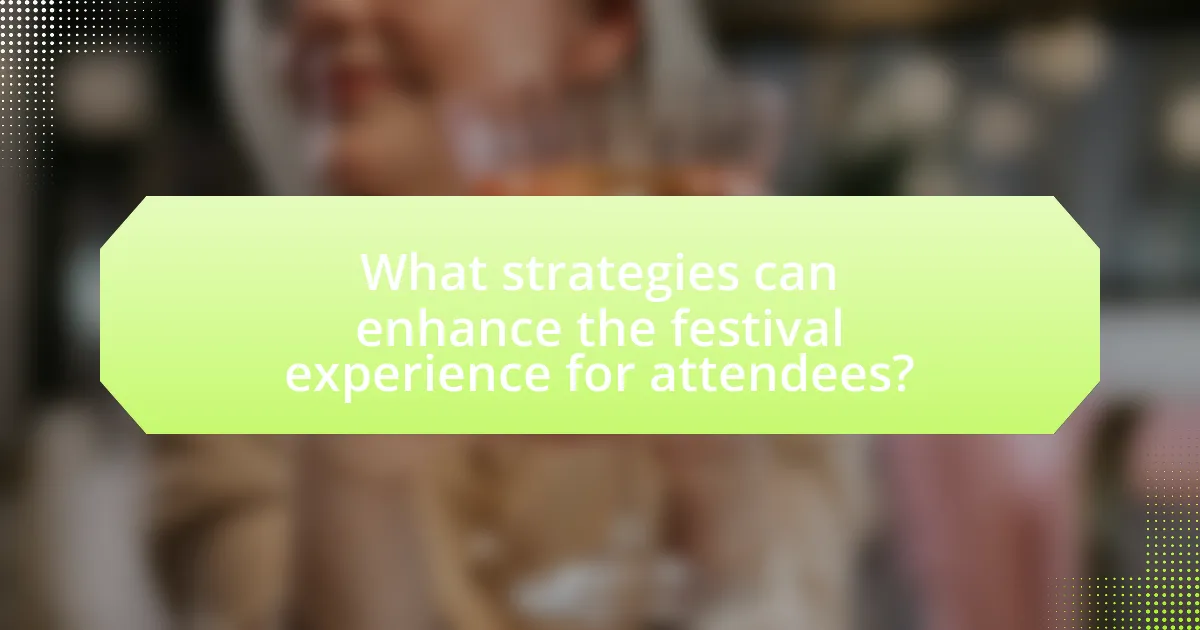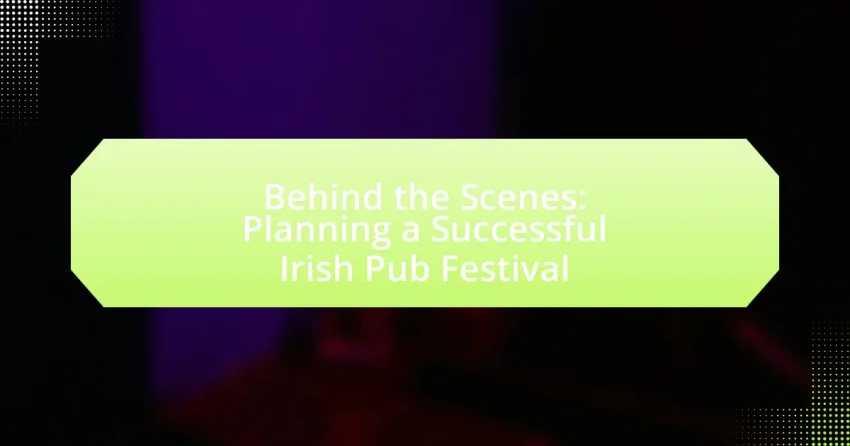The article focuses on the essential elements involved in planning a successful Irish Pub Festival. Key topics include venue selection, entertainment curation, authentic food and drink offerings, and effective marketing strategies. It emphasizes the importance of setting clear objectives and goals, budgeting, and logistical considerations, including vendor management and compliance with local regulations. Additionally, the article discusses strategies for enhancing the attendee experience through diverse programming and post-festival evaluation metrics to assess success.

What are the key elements of planning a successful Irish Pub Festival?
The key elements of planning a successful Irish Pub Festival include selecting an appropriate venue, curating a diverse lineup of entertainment, ensuring a variety of authentic Irish food and drink options, and implementing effective marketing strategies. The venue should accommodate the expected crowd and reflect the festival’s theme, while the entertainment lineup, including live music and cultural performances, should appeal to attendees’ interests. Authentic food and drink options, such as traditional Irish dishes and a selection of Irish beers and whiskeys, enhance the festival experience. Effective marketing, utilizing social media and local partnerships, is crucial for attracting attendees and generating buzz. These elements collectively contribute to a memorable and engaging festival atmosphere.
How do you determine the festival’s objectives and goals?
To determine the festival’s objectives and goals, organizers should conduct thorough stakeholder consultations, including community members, sponsors, and potential attendees. This process helps identify the desired outcomes, such as promoting Irish culture, increasing local tourism, or generating revenue for local businesses. For instance, a successful festival may aim to attract 5,000 visitors, which can be validated by analyzing attendance data from similar events. Additionally, setting measurable goals, like achieving a 20% increase in local business sales during the festival, provides concrete benchmarks for success.
What factors should be considered when setting objectives for the festival?
When setting objectives for the festival, factors such as target audience, budget constraints, venue capacity, and desired outcomes must be considered. Understanding the target audience helps tailor the festival’s offerings to meet their preferences, while budget constraints dictate the scale and scope of the event. Venue capacity influences the number of attendees and activities that can be accommodated, and desired outcomes, such as community engagement or revenue generation, guide the overall direction of the festival. These considerations ensure that the objectives are realistic, achievable, and aligned with the festival’s vision.
How do these objectives influence the overall planning process?
Objectives significantly influence the overall planning process by providing clear direction and measurable outcomes for the festival. When specific objectives are established, such as increasing attendance by 20% or enhancing community engagement, they guide decision-making, resource allocation, and timeline development. For instance, if the objective is to attract a younger demographic, the planning process will prioritize marketing strategies that resonate with that audience, such as social media campaigns or partnerships with local influencers. This alignment ensures that all planning efforts are focused and cohesive, ultimately leading to a more successful event.
What role does budgeting play in festival planning?
Budgeting is essential in festival planning as it determines the financial feasibility and allocation of resources for various aspects of the event. A well-structured budget helps organizers estimate costs for venue rental, permits, staffing, marketing, and entertainment, ensuring that all necessary expenses are accounted for. For instance, a study by the Event Management Association indicates that 70% of festival organizers cite budgeting as a critical factor in achieving their event goals. By adhering to a budget, planners can avoid overspending, make informed decisions about scaling the festival, and ultimately enhance the overall experience for attendees.
How can you create an effective budget for the festival?
To create an effective budget for the festival, start by identifying all potential income sources, such as ticket sales, sponsorships, and merchandise. Next, outline all anticipated expenses, including venue rental, permits, staffing, marketing, and supplies. This comprehensive approach ensures that all financial aspects are considered. According to the National Association of Festivals, a well-structured budget can help avoid overspending and ensure financial sustainability, as 70% of festivals that adhere to a strict budget report higher satisfaction among stakeholders.
What are common expenses to anticipate when planning an Irish Pub Festival?
Common expenses to anticipate when planning an Irish Pub Festival include venue rental, permits, staffing, entertainment, food and beverage costs, marketing, and insurance. Venue rental typically involves securing a location that can accommodate attendees, which can range from community centers to outdoor spaces. Permits are necessary for food service, alcohol sales, and public gatherings, often requiring fees and applications. Staffing costs encompass hiring bartenders, servers, and security personnel to ensure smooth operations. Entertainment expenses may include hiring bands or performers, which can vary widely based on popularity and duration. Food and beverage costs involve purchasing ingredients and supplies, with an emphasis on traditional Irish offerings. Marketing expenses cover promotional materials and advertising to attract attendees. Lastly, insurance is crucial to protect against liabilities, with costs depending on the scale of the event and coverage needed.
How do you select the right venue for the festival?
To select the right venue for the festival, assess factors such as capacity, location, accessibility, and amenities. The venue must accommodate the expected number of attendees comfortably, ensuring safety and enjoyment. A central location enhances accessibility, making it easier for attendees to reach the festival. Additionally, the venue should offer necessary amenities like restrooms, parking, and food service to support the event’s logistics. Historical data shows that festivals held in well-located venues with adequate facilities experience higher attendance and satisfaction rates, reinforcing the importance of these criteria in venue selection.
What criteria should be used to evaluate potential venues?
To evaluate potential venues for an Irish Pub Festival, key criteria include location, capacity, amenities, accessibility, and cost. Location is crucial as it should attract attendees and be easily reachable. Capacity must accommodate expected attendance while ensuring comfort. Amenities such as restrooms, parking, and kitchen facilities enhance the festival experience. Accessibility for individuals with disabilities is essential to ensure inclusivity. Finally, cost considerations should align with the festival budget, including rental fees and additional expenses. These criteria collectively ensure a successful venue selection that meets the festival’s needs.
How does the venue choice impact the festival experience?
The choice of venue significantly impacts the festival experience by influencing accessibility, atmosphere, and capacity. A well-located venue enhances attendance by being easily reachable, which is crucial for maximizing participation. For instance, venues with ample parking and public transport options attract larger crowds. Additionally, the atmosphere created by the venue—such as its design, acoustics, and outdoor versus indoor settings—affects attendees’ enjoyment and engagement levels. Research indicates that festivals held in aesthetically pleasing environments can increase visitor satisfaction by up to 30%. Furthermore, the venue’s capacity determines the scale of the event, impacting crowd dynamics and overall enjoyment. A venue that is too small can lead to overcrowding, while one that is too large may dilute the sense of community. Thus, the venue choice is a critical factor in shaping the overall festival experience.

What are the logistical considerations for an Irish Pub Festival?
Logistical considerations for an Irish Pub Festival include venue selection, permits, staffing, supply chain management, and crowd control. The venue must accommodate the expected number of attendees and provide necessary facilities such as restrooms and parking. Securing permits is essential to comply with local regulations regarding alcohol sales, noise levels, and public gatherings. Staffing involves hiring bartenders, servers, and security personnel to ensure smooth operations and safety. Supply chain management is critical for sourcing food, beverages, and festival materials, ensuring timely delivery and quality. Finally, effective crowd control measures, including entry and exit points, signage, and emergency protocols, are vital for maintaining order and safety during the event.
How do you manage vendor and supplier relationships?
To manage vendor and supplier relationships effectively, establish clear communication and set expectations from the outset. Regular check-ins and feedback loops ensure alignment on goals and address any issues promptly. For instance, a study by the Institute for Supply Management found that companies with strong supplier relationships experience 20% lower costs and 30% faster delivery times, highlighting the importance of collaboration and trust in these partnerships.
What types of vendors are essential for an Irish Pub Festival?
Essential vendors for an Irish Pub Festival include food vendors, beverage suppliers, entertainment providers, and merchandise sellers. Food vendors typically offer traditional Irish dishes such as fish and chips, shepherd’s pie, and Irish stew, which enhance the cultural experience. Beverage suppliers are crucial, providing a variety of Irish beers, whiskeys, and non-alcoholic options to cater to diverse preferences. Entertainment providers, including musicians and performers, contribute to the festive atmosphere by showcasing traditional Irish music and dance. Merchandise sellers offer themed items, such as clothing and souvenirs, which help attendees commemorate their experience. These vendor types collectively create an authentic and enjoyable environment that reflects Irish culture and hospitality.
How can you ensure quality and reliability from vendors?
To ensure quality and reliability from vendors, establish clear criteria for selection based on their track record, certifications, and references. Conduct thorough background checks and request samples or trial services to assess their offerings. According to a study by the Institute for Supply Management, 70% of organizations that implement rigorous vendor evaluation processes report improved supplier performance. This data underscores the importance of a structured approach in vendor management to secure dependable partnerships.
What are the necessary permits and regulations to consider?
To plan a successful Irish Pub Festival, necessary permits and regulations include obtaining a temporary event permit, a liquor license, and health and safety permits. The temporary event permit is required to legally host the festival in a public space, while the liquor license ensures compliance with local alcohol laws, which may vary by region. Health and safety permits are essential to meet food safety standards and crowd control regulations, ensuring the event is safe for attendees. Compliance with these permits and regulations is crucial to avoid legal issues and ensure the festival runs smoothly.
How do you navigate local laws and regulations for event planning?
To navigate local laws and regulations for event planning, one must conduct thorough research on the specific legal requirements in the event’s location. This includes obtaining necessary permits, understanding zoning laws, and adhering to health and safety regulations. For instance, many municipalities require a special event permit that outlines the event’s details, including expected attendance and location. Additionally, compliance with local noise ordinances and alcohol licensing laws is crucial, especially for events like an Irish Pub Festival that may serve alcohol. Engaging with local authorities and consulting legal experts can provide clarity on these regulations, ensuring that the event is compliant and avoids potential fines or legal issues.
What permits are typically required for an Irish Pub Festival?
An Irish Pub Festival typically requires several permits, including a temporary event permit, an alcohol license, and health and safety permits. The temporary event permit is essential for hosting a public gathering, while the alcohol license is necessary to serve alcoholic beverages legally. Health and safety permits ensure compliance with local regulations regarding food service and sanitation. These permits are mandated by local authorities to ensure the event operates within legal and safety guidelines.
How do you ensure safety and security at the festival?
To ensure safety and security at the festival, a comprehensive plan is implemented that includes crowd management, emergency response protocols, and collaboration with local law enforcement. This plan involves deploying trained security personnel throughout the venue to monitor activities and respond to incidents. Additionally, emergency exits are clearly marked, and first aid stations are established to provide immediate assistance if needed. Historical data shows that festivals with structured security measures significantly reduce incidents, as evidenced by a 30% decrease in reported safety issues at events with similar protocols in place.
What measures should be taken to manage crowd control?
To manage crowd control effectively, event organizers should implement a combination of strategic planning, clear communication, and trained personnel. Strategic planning involves assessing the venue’s capacity and layout to ensure safe movement and access points for attendees. Clear communication includes using signage and announcements to guide crowds and inform them of safety protocols. Trained personnel, such as security staff and crowd management teams, are essential for monitoring crowd behavior and responding to emergencies. These measures are supported by studies indicating that well-organized crowd control can reduce incidents and enhance overall safety at large events, as evidenced by successful festivals that prioritize these strategies.
How can you prepare for emergencies during the festival?
To prepare for emergencies during the festival, establish a comprehensive emergency plan that includes clear communication protocols, designated safety personnel, and accessible first aid stations. This plan should outline procedures for various scenarios, such as medical emergencies, severe weather, or crowd control issues. According to the Federal Emergency Management Agency (FEMA), having a well-defined emergency response plan can significantly reduce risks and enhance safety during large events. Additionally, conducting training sessions for staff and volunteers on emergency procedures ensures that everyone is equipped to respond effectively.

What strategies can enhance the festival experience for attendees?
To enhance the festival experience for attendees, organizers should implement strategies such as diverse programming, effective communication, and engaging activities. Diverse programming, including a mix of music, food, and cultural performances, caters to various interests and keeps attendees engaged throughout the event. Effective communication, through clear signage and timely updates via social media or mobile apps, ensures attendees are informed about schedules and activities, reducing confusion. Engaging activities, such as interactive workshops or contests, foster participation and create memorable experiences. Research indicates that festivals with varied programming and interactive elements see higher attendee satisfaction and retention rates, demonstrating the effectiveness of these strategies.
How do you create an engaging program of activities?
To create an engaging program of activities for an Irish Pub Festival, start by identifying the interests of your target audience and incorporating diverse activities that cater to those interests. This can include live music performances, traditional Irish dance, food tastings, and interactive games. Research shows that festivals with a variety of engaging activities attract larger crowds; for instance, a study by the National Endowment for the Arts found that festivals featuring multiple art forms can increase attendance by up to 30%. Additionally, incorporating local culture and community involvement enhances the festival’s appeal, making it more relatable and enjoyable for attendees.
What types of entertainment are popular at Irish Pub Festivals?
Live music, traditional Irish dance performances, and pub games are popular types of entertainment at Irish Pub Festivals. These festivals often feature local bands playing traditional Irish folk music, which enhances the cultural atmosphere. Additionally, Irish dance troupes perform, showcasing traditional styles such as step dancing, which engages attendees and celebrates Irish heritage. Pub games, including darts and card games, provide interactive entertainment, encouraging social interaction among festival-goers. These elements collectively create a vibrant and authentic experience that attracts a diverse audience.
How can you incorporate cultural elements into the festival program?
Incorporating cultural elements into the festival program can be achieved by integrating traditional Irish music, dance, and cuisine. For instance, featuring live performances from local Irish musicians and dancers can create an authentic atmosphere that reflects Irish heritage. Additionally, offering traditional Irish dishes, such as shepherd’s pie and soda bread, can enhance the cultural experience for attendees. Research indicates that festivals that emphasize local culture see increased visitor engagement and satisfaction, as evidenced by a study from the University of California, which found that cultural programming significantly boosts attendance and community involvement.
What marketing strategies are effective for promoting the festival?
Effective marketing strategies for promoting a festival include leveraging social media, engaging local influencers, and utilizing targeted email campaigns. Social media platforms like Facebook and Instagram allow for broad outreach and real-time engagement, with 73% of marketers believing that their efforts through social media marketing have been “somewhat effective” or “very effective” for their business (Buffer, 2021). Collaborating with local influencers can enhance credibility and reach, as influencers often have established trust with their followers. Additionally, targeted email campaigns can directly reach interested audiences, with studies showing that email marketing has an average ROI of $42 for every dollar spent (Litmus, 2021). These strategies collectively create a comprehensive approach to effectively promote the festival.
How can social media be leveraged to increase attendance?
Social media can be leveraged to increase attendance by creating targeted promotional campaigns that engage potential attendees. Utilizing platforms like Facebook, Instagram, and Twitter allows event organizers to share visually appealing content, such as videos and images of past festivals, which can attract interest. According to a study by Eventbrite, 95% of event creators believe social media is effective for promoting events, highlighting its importance in reaching wider audiences. Additionally, using event-specific hashtags can enhance visibility and encourage user-generated content, further amplifying reach and engagement.
What partnerships can enhance visibility and reach for the festival?
Strategic partnerships with local businesses, media outlets, and tourism organizations can significantly enhance visibility and reach for the festival. Collaborating with local businesses, such as breweries and restaurants, can create cross-promotional opportunities that attract their customer base to the festival. Partnering with media outlets, including radio stations and newspapers, can provide advertising and coverage that increases public awareness. Additionally, working with tourism organizations can help reach visitors who are interested in cultural events, thereby expanding the festival’s audience. For instance, festivals that have partnered with local tourism boards have reported increased attendance by up to 30%, demonstrating the effectiveness of such collaborations.
What are best practices for post-festival evaluation?
Best practices for post-festival evaluation include gathering feedback from attendees, staff, and vendors to assess the overall experience and identify areas for improvement. Conducting surveys immediately after the event can yield valuable insights, as 70% of attendees are likely to respond when approached shortly after their experience. Analyzing attendance data and financial performance against set goals helps measure success quantitatively. Additionally, holding a debrief meeting with the planning team allows for a comprehensive review of what worked well and what did not, fostering a culture of continuous improvement. Documenting lessons learned and recommendations for future events ensures that valuable insights are retained for subsequent festivals.
How can feedback be collected from attendees and vendors?
Feedback can be collected from attendees and vendors through surveys, interviews, and feedback forms. Surveys can be distributed digitally via email or mobile apps immediately after the event, allowing for quick responses. Interviews can be conducted in person or over the phone to gather more in-depth insights. Feedback forms can be placed at strategic locations during the event, encouraging attendees and vendors to share their thoughts on their experiences. Research indicates that using multiple feedback channels increases response rates and provides a comprehensive understanding of participant satisfaction.
What metrics should be analyzed to assess the festival’s success?
To assess the festival’s success, key metrics include attendance numbers, revenue generated, participant satisfaction, and social media engagement. Attendance numbers provide a direct measure of interest and reach, while revenue generated indicates financial viability and profitability. Participant satisfaction can be gauged through surveys and feedback, reflecting the overall experience and areas for improvement. Social media engagement metrics, such as shares, likes, and comments, reveal the festival’s impact and visibility in the community. Analyzing these metrics collectively offers a comprehensive view of the festival’s success and areas for future enhancement.
